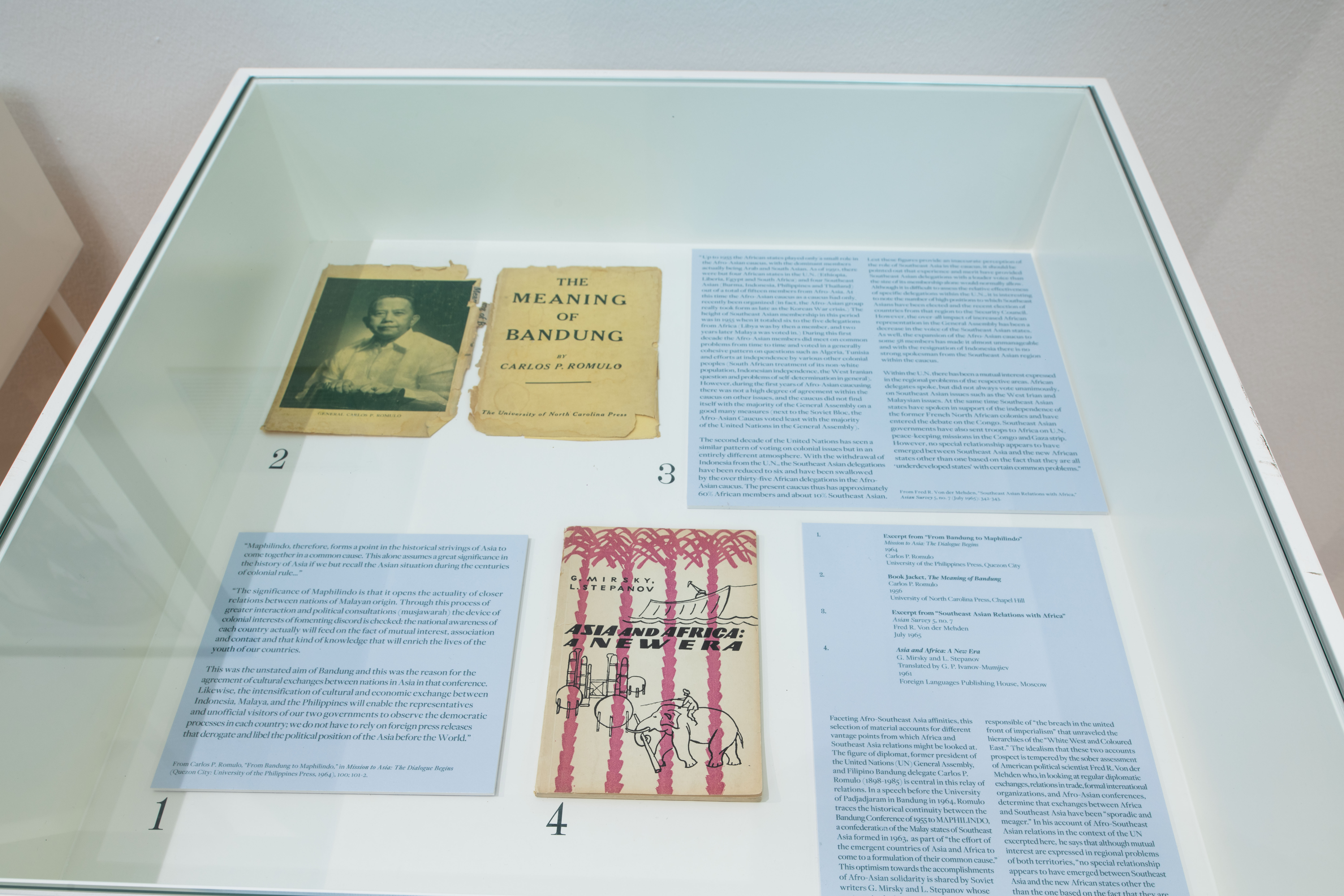
Portrait of Huey Newton, Black Panther
Party's founder and Minister of Defense,
seated on a peacock chair
1967
Reproduction
45.7cm x 30.5cm
The Peacock chair, also known as the Manila chair, is a single-seat chair with an oversized backrest that resembles a fully fanned peacock’s tail. It is made of rattan, a pliable reed harvested from a palm indigenous to the Malay world. It is woven into baskets and chairs, mostly as furniture for export. At some point it was known as “manila,” after the Philippine capital where perhaps most of rattan furniture comes from. One account historicizes the production of the chair within the penitentiary system of the Philippines with jailed criminals being tasked to weave home furnishings. In this iconic portrait taken in 1967, Black Panther Party founder and Minister of Defense Huey Newton is seen seated on a Peacock chair. The Black Panther Party is an anti-police brutality political organization led by African American students and founded in 1966 in Oakland. He is framed on either side by what annotators have identified as “traditional African shields.” There is a zebra carpet on the floor. In his right hand he holds a rifle, on his left is a spear. The chair resembles a throne, his gait regal, the objects surrounding him evoking power and violence. The Peacock chair participates in this iconography that recalls conventional representations of African culture—at once regal and unfamiliar, exotic.

Book display at National Library featuring books about Africa, including titles such as Africa in the United Nations; Handbook of African Affairs; The African Presence in World Affairs; Kenya a Political History the Colonial Period; The Mind of Africa; Democracy in Africa; and Africa and World Order
29 October 1965
Ministry of Information and the Arts Collection, courtesy of National Archives of Singapore
20.3cm x 13.5cm

A Letter from P. Ramlee on Pustaka Maphilindo
Filem Malaysia
1964
Private Collection of Wong Han Min
29.7cm x 21cm
Presented alongside Huey Newton’s famous portrait, these two objects speak to cultural resonances that the international and regional imaginary of solidarity had upon ‘everyday’ life. The 1965 book display from the National Library speaks to a general interest and awareness of Africa and its postcolonial independent projects in Singapore. While the letter by Malaysian filmmaker P. Ramlee (1929-1973) about his relationship to the Maphilindo Library and its relationship to the Filem Malaysia magazine speaks to how Maphilindo as an idea inspired and was navigated by cultural producers at the time.

1. Excerpt from “From Bandung to Maphilindo”
Mission to Asia: The Dialogue Begins
1964
Carlos P. Romulo
University of the Philippines Press
Quezon City
Mission to Asia: The Dialogue Begins
1964
Carlos P. Romulo
University of the Philippines Press
Quezon City
2. Book Jacket, The Meaning of Bandung
Carlos P. Romulo
1956
University of North Carolina Press
Chapel Hill
Carlos P. Romulo
1956
University of North Carolina Press
Chapel Hill
3. Excerpt from “Southeast Asian Relations with Africa”
Asian Survey 5, no. 7
Fred R. von der Mehden
July 1965
Asian Survey 5, no. 7
Fred R. von der Mehden
July 1965
4. Asia and Africa: A New Era
G. Mirsky and L. Stepanov
Translated by G. P. Ivanov-Mumjiev
1961
Foreign Languages Publishing House
Moscow
G. Mirsky and L. Stepanov
Translated by G. P. Ivanov-Mumjiev
1961
Foreign Languages Publishing House
Moscow
Faceting Afro-Southeast Asia affinities, this selection of material accounts for different vantage points from which Africa and Southeast Asia relations might be looked at. The figure of diplomat, former president of the United Nations (UN) General Assembly, and Filipino Bandung delegate Carlos P. Romulo (1898-1985) is central in this relay of relations. In a speech before the University of Padjadjaram in Bandung in 1964, Romulo traces the historical continuity between the Bandung Conference of 1955 to Maphilindo, a confederation of the Malay states of Southeast Asia formed in 1963, as part of “the effort of the emergent countries of Asia and Africa to come to a formulation of their common cause.” This optimism towards the accomplishments of Afro-Asian solidarity is shared by Soviet writers G. Mirsky and L. Stepanov whose account in the book Asia and Africa: A New Era imagines this along sharper ideological lines wherein Russia’s October Revolution is responsible of “the breach in the united front of imperialism” that unraveled the hierarchies of the “White West and Coloured East.”
The idealism that these two accounts prospect is tempered by the sober assessment of American political scientist Fred R. von der Mehden who, in looking at regular diplomatic exchanges, relations in trade, formal international organizations, and Afro-Asian conferences, determine that exchanges between Africa and Southeast Asia have been “sporadic and meager.” In his account of Afro-Southeast Asian relations in the context of the UN excerpted here, he says that although mutual interest are expressed in regional problems of both territories, “no special relationship appears to have emerged between Southeast Asia and the new African states other the than the one based on the fact that they are all ‘underdeveloped states’ with certain common problems.”

Excerpt from “A Weekend with Richard Wright”
PMLA 126, no. 3
Beb Vuyk
Translated by Keith Foulcher
May 2011
PMLA 126, no. 3
Beb Vuyk
Translated by Keith Foulcher
May 2011